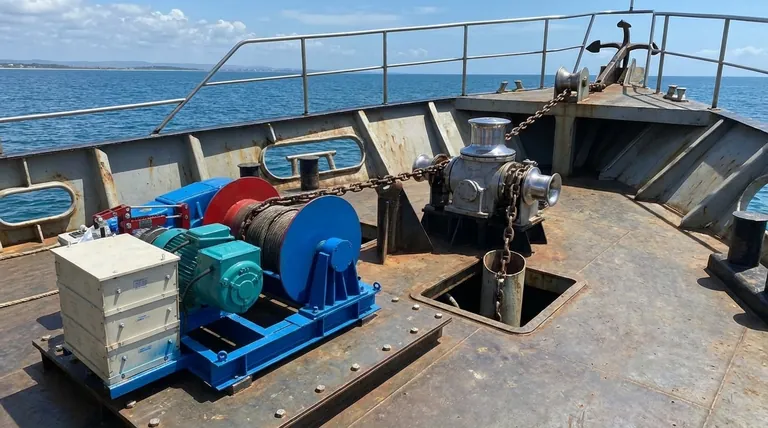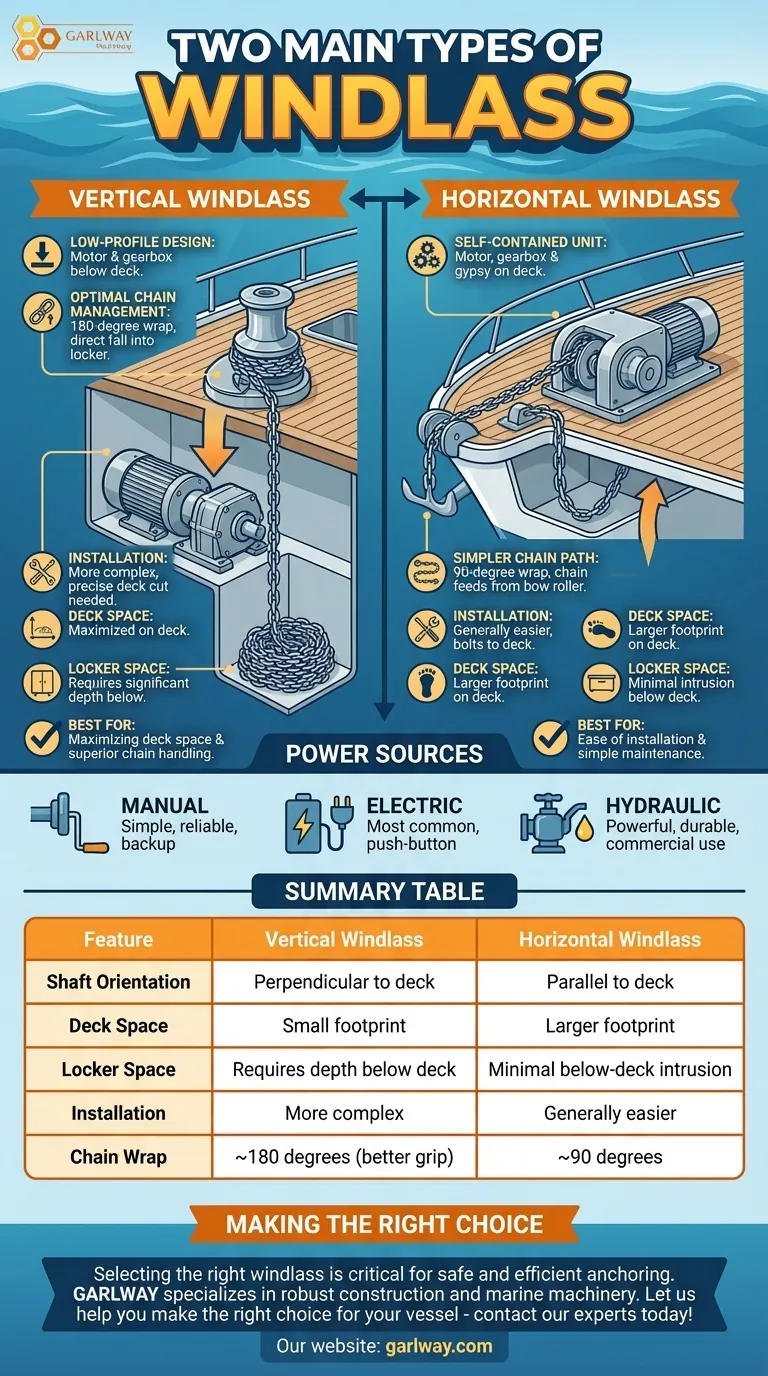The two primary types of anchor windlass are defined by the orientation of their main shaft: horizontal and vertical. A horizontal windlass has a shaft that runs parallel to the deck, while a vertical windlass has a shaft that is mounted perpendicular to the deck.
The choice between a vertical and horizontal windlass is not merely aesthetic. It is a fundamental decision that dictates how the unit fits on your boat, impacting deck space, anchor locker requirements, and the complexity of installation.

The Fundamental Difference: Shaft Orientation
The primary way to classify a windlass is by its physical layout. This design choice has significant consequences for both performance and installation.
What is a Vertical Windlass?
In a vertical windlass, the motor and gearbox are located below the deck, directly under the unit.
Only the top part of the windlass, which includes the gypsy (for chain) and sometimes a capstan (for rope), is visible on deck. This results in a very low-profile and clean look.
The chain wraps around the gypsy approximately 180 degrees, providing excellent grip and control before dropping directly down into the anchor locker.
What is a Horizontal Windlass?
A horizontal windlass is a self-contained unit where the motor, gearbox, and gypsy are all housed together in a casing mounted on top of the deck.
The entire mechanism is visible and accessible from the deck. The chain approaches the gypsy from the bow roller, wraps around it for about 90 degrees, and is then fed down into the anchor locker.
Understanding the Trade-offs
Choosing between these two orientations involves balancing key factors related to your vessel's specific design and your personal priorities.
Deck Space vs. Locker Space
A vertical windlass has a much smaller footprint on deck, freeing up valuable space. However, it requires significant space below deck to accommodate the motor and gearbox.
A horizontal windlass takes up more surface area on the deck but has minimal intrusion into the space below. This makes it ideal for boats with shallow or unusually shaped anchor lockers.
Installation and Maintenance
Horizontal models are generally easier to install. Because the entire unit is self-contained, installation typically involves bolting it to the deck and running the wiring. Maintenance is also simpler as all components are readily accessible.
Vertical models require a more complex installation. This involves cutting a larger, more precise hole in the deck for the shaft and motor assembly and ensuring perfect alignment.
Chain Handling and "Chain Fall"
The vertical windlass often provides superior chain handling. The 180-degree wrap on the gypsy offers a more secure grip on the anchor rode.
This design also promotes a better "chain fall," allowing the chain to drop straight down into the center of the locker. This helps prevent the chain from piling up in one spot and jamming the windlass.
The Other Critical Factor: Power Source
While orientation is the primary design distinction, windlasses are also categorized by how they are powered.
Manual Windlasses
These are operated by hand with a lever or crank. They are simple, reliable, and not dependent on your boat's electrical system, making them an excellent choice for smaller vessels or as a robust backup.
Electric Windlasses
This is the most common type on modern recreational boats. They offer push-button convenience and are powerful enough for most situations, but they require a capable battery bank and proper heavy-gauge wiring to function safely and effectively.
Hydraulic Windlasses
Typically reserved for larger yachts and commercial vessels, hydraulic systems are exceptionally powerful and durable. However, they are also the most complex and expensive, requiring a dedicated hydraulic pump and plumbing.
Making the Right Choice for Your Boat
Your boat's design and your priorities will determine the best windlass for your needs.
- If your primary focus is maximizing deck space and ensuring the best chain management: A vertical windlass is the superior choice, provided you have sufficient depth and space in your anchor locker.
- If your primary focus is ease of installation and simpler maintenance: A horizontal windlass is the most straightforward option, especially when retrofitting onto an existing boat.
- If you have a smaller boat or want an ultra-reliable, non-powered option: A manual windlass offers unmatched simplicity and dependability.
Ultimately, understanding these core differences in orientation and power is the key to selecting a windlass that serves you reliably for years to come.
Summary Table:
| Feature | Vertical Windlass | Horizontal Windlass |
|---|---|---|
| Shaft Orientation | Perpendicular to deck | Parallel to deck |
| Deck Space | Small footprint | Larger footprint |
| Locker Space | Requires depth below deck | Minimal below-deck intrusion |
| Installation | More complex | Generally easier |
| Chain Wrap | ~180 degrees (better grip) | ~90 degrees |
Selecting the right windlass is critical for safe and efficient anchoring. GARLWAY specializes in robust construction and marine machinery, offering durable solutions for marine contractors and vessel operators globally. Whether you need reliable anchoring systems or other heavy-duty equipment, our expertise ensures optimal performance for your specific requirements.
Let us help you make the right choice for your vessel — contact our experts today to discuss your needs!
Visual Guide

Related Products
- Electric Hoist Winch Boat Anchor Windlass for Marine Applications
- Heavy Duty Electric Boat Winch Windlass Anchor
- Warn Winch Windlass Boat Trailer Winch
- Portable Concrete Mixer Machine Equipment for Mixing Concrete
- Commercial Construction Mixer Machine for Soil Cement Mixing Concrete
People Also Ask
- How should the hoist winch be debugged after installation? A 3-Phase Guide to Ensure Safety & Reliability
- Why won't my electric hoist go up or down? A Step-by-Step Troubleshooting Guide
- What are the key precautions to follow when using an electric hoist? Ensure Safe and Efficient Lifting Operations
- What are the advantages of an electrically operated trailer winch? Enhance Safety & Control for Your Trailer
- How do electric hoists help prevent workplace injuries? Engineer a Safer, More Efficient Workspace







